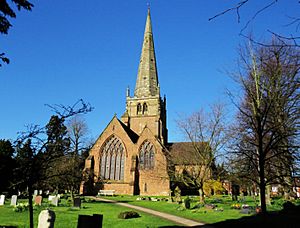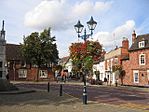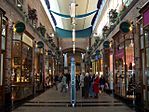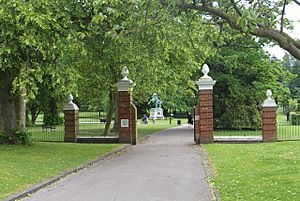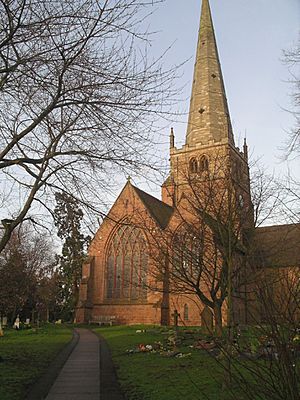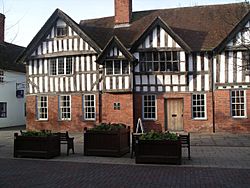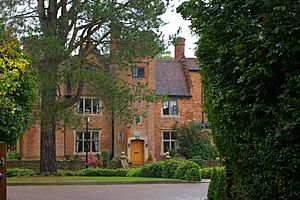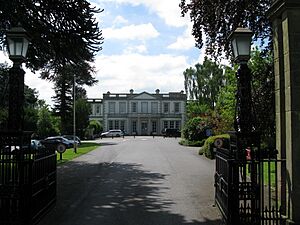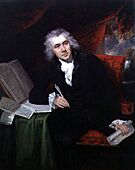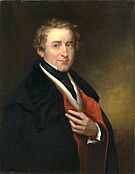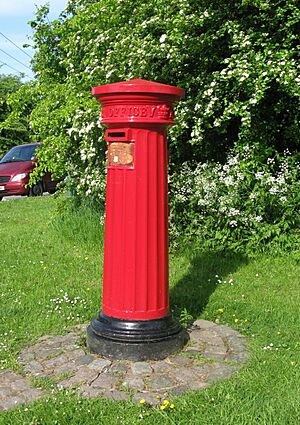Solihull facts for kids
Quick facts for kids Solihull |
|
|---|---|
| Town | |
|
Clockwise from top: St Alphege Church, Touchwood Shopping Centre, Malvern Park and Solihull town square |
|
| Population | 126,577 (2021 Census) |
| Demonym | Silhillian |
| OS grid reference | SP1579 |
| • London | 110 mi (180 km) SE |
| Metropolitan borough |
|
| Metropolitan county | |
| Region | |
| Country | England |
| Sovereign state | United Kingdom |
| Post town | SOLIHULL |
| Postcode district | B36, B37, B90–B94 |
| Dialling code | 0121 |
| Police | West Midlands |
| Fire | West Midlands |
| Ambulance | West Midlands |
| EU Parliament | West Midlands |
| UK Parliament |
|
Solihull (/ˈsɒlihʌl, ˈsoʊl-, ˌsoʊliˈhʌl/ so(h)l-EE-hul-,_-soh-LEE-hul) is a market town and the administrative centre of the Metropolitan Borough of Solihull, in the West Midlands, England. Solihull is situated on the River Blythe in the Forest of Arden area. The town had a population of 126,577 at the 2021 Census, and its wider borough had a population of 216,240. The town is located 8 miles (12 km) southeast of Birmingham and 14 miles (21 km) west of Coventry.
Solihull itself is mostly urban; however, the larger borough is rural in character, with many outlying villages, and three quarters of the borough designated as green belt. The town and its borough, which has been part of Warwickshire for most of its history, has roots dating back to the 1st century BC, and was further formally established during the medieval era. Today the town is famed as, amongst other things, the birthplace of the Land Rover car marque, home of the training facilities for the British Equestrian teams, and is considered to be one of the most prosperous areas in the UK.
Contents
Toponym
Solihull's name is commonly thought to have derived from the position of its arden stone parish church, St Alphege, on a 'soily' hill. The church was built on a hill of stiff red marl, which turned to sticky mud in wet weather.
History
Early history
The land now forming Solihull was once covered in the ancient Forest of Arden.
The earliest known settlement in the area was at Berry Mound, Shirley, which was the site of an Iron Age Hill Fort, a fortified village protected by earth banks, dating back to the 1st century BC and which covered approximately 11 acres (4.5 ha). The name Shirley means either 'a bright clearing' or 'a border clearing' in the Forest of Arden.
During the later Iron Age the River Cole, which feeds the River Blythe, is believed to have been the border between the Corieltauvi and the Cornovii, with Solihull forming the junction of the two powerful Celtic Tribes.
Throughout the Roman occupation of Britain it was held that no Roman roads made it through the Forest of Arden because it was so dense. The nearest known major Roman settlements being at Grimstock Hill on the Solihull border, Metchley Fort (around 8.5 miles north west), and Alcester (around 15 miles south).
Anglo Saxon era
By the Anglo Saxon era, the forest of Arden was part of the Kingdom of Mercia. An assart settlement known as the manor of Ulverlei, meaning 'Wulfhere's clearing' was established, with its centre north east of the hillfort at Shirely. Wulfhere was the first Christian King of all Mercia. The settlement was a clearing in the dense woodland of the Forest of Arden, with the land farmed in common. The older settlement at Shirely was considered part of the new Manor of Ulverlei. This status as a clearing in the countryside is still reflected to this day in the town motto, "Urbs in rure" or "town in the country".
Local folklore holds that as part of his campaigns against the Viking invasion in the mid 9th century Alfred the Great fought a battle against the Danes at Berry Mound, Shirley.
After the absorption of Mercia into the rest of England, Ulverlei became the property of the Earls of Mercia. The first of these was Leofric, husband of Lady Godiva, heroine of the Warwickshire legend. The manor of Ulverlei later passed to Leofric's grandson, Edwin, Earl of Mercia who held it until his death in 1071. Leofric's great-nephew, Thorkell of Arden, would become progenitor of the locally prominent Arden family, one of the few Anglo Saxon families to retain their land holdings after the Norman Conquest, and eventually settling in their primary estate in Castle Bromwich, today in the Borough of Solihull.
Early medieval era
In 1086, it was recorded that the Manor of Ulverlei was now held by Cristina, great-granddaughter of Ethelred the Unready, daughter of Edward the Exile, and sister of the last Anglo Saxon King Edgar Aetheling. Shortly after 1086, Christina entered the nunnery of Romsey Abbey in Hampshire. Her lands were granted to the Norman Ralph de Limesy. The extent of the area historically considered the manor of Ulverlei is demarked by an area called 'Worlds End', a historical naming practice indicating that people did not live beyond there.
It was between 1170 and 1180 that the de Limsey family founded the settlement of 'Solihull' as a "planted borough" or planned village to the south of Ulverli. It was called a borough simply because the de Limsey Lord of the Manor offered free burgage tenure where residents were free, rent-paying burgesses, rather than villeins owing service to the Lord of the Manor. By the time of Edward I, Ulverlie was sub-infeudated into the newly created Manor of Solihull, and became known as the 'Old Town', contracted to its present name, Olton to distinguish itself from the New Town of Solihull.
The de Limsey family held the Manor of Solihull, until Ralph's great-granddaughter married Hugh de Odingsells, whose family were thought to be of Flemish origin.
The Odingsells were the Lords of the Manor of Ulverley, and later after its subinfeudation, Solihull, from the 12th century and are believed to have constructed a castle on the site now known as Hobs Moat (a possible corruption of Odingsells' Moat). The castle was occupied until around the 14th century. The Odingsells were relatives of the powerful Clinton Earls of Huntingdon of Maxstoke Castle (around 8 miles north east of Hobs Moat), whose relatives would also control nearby Coleshill Manor (around 6 miles north east of Hobs Moat), Kenilworth Castle (around 13 miles south east of Hobs Moat) and Baddesley Clinton (around 8 miles south of Hobs Moat).
The red sandstone parish church of St. Alphege dates from a similar period to Hobs Moat and is a large and handsome example of English Gothic church architecture, with a traditional spire 168 feet (51 metres) high, making it visible from a great distance. It is located at the head of High Street and is a Grade I listed building. It was founded in about 1220 by Hugh de Oddingsell. A chantry chapel was also founded there by Sir William de Oddingsell in 1277 and the upper chapel in St Alphege was built for a chantry.
By 1242, the Manor of Solihull was granted a Royal charter to hold a weekly market and an annual fair "on the vigil, the feast and the morrow of St Alphege" (18-20 April). It was around this time that Solihull became a hub for its surrounding parishes.
The town of Solihull would later absorb the nearby settlement of Longdon. The first recorded reference to Longdon was in 1086 as 'Langedone', meaning the 'long hill'. The 'long hill' in question was the hill on what is now Solihull's Marsh Lane and Yew Tree Lane, leading from the River Blythe up onto Elmdon Heath. The Longdon Manor House was at its edge on Copt Heath. In 1161 the Manor of Longdon had been property of Ketelberne de Langdon, who founded Henwood Priory and gave his name to the settlement of Catherine-de-Barnes (a corruption of the name Ketelberne). The assimilation of Longdon into Solihull was so total that few references exist today indicating it was ever a separate place.
The Longdon area bordered onto the settlement of Hampton in Arden, appearing in the Domesday Survey of 1086 as 'Hantone'. Despite bordering Solihull, Hampton in Arden would not be incorporated into the borough of Solihull until later. From the middle of the 12th century Hampton in Arden was owned by the de Arden family, and also included the then hamlet of Knowle. Knowle would become a royal manor in 1285 when the de Arden family sold it to King Edward I and Queen Eleanor. In 1396, Walter Cook applied for a faculty to build a church in 'Knoll', so the villagers would no longer have to cross the treacherous waters of the river Blythe to get to church, and this was granted by Pope Boniface IX on 4 May 1396. By 1402 the church was consecrated and Knowle broke away from Hampton in Arden, later becoming part of the borough of Solihull.
Near Knowle lies the settlement of Temple Balsall, part of the borough of Solihull, that was founded by the Knights Templar, who farmed about 650 acres (2.6 km2) of the estate in the 12th century, and established the church and the Balsall Preceptory.
Later medieval era
By 1295, the Manor of Solihull had passed from the Odingsells via heiress to the de Birmingham family, however they in turn quickly passed it into the Le Despencer family. The Despencers found themselves at odds with the Trussell family of nearby Nuthurst (now in the borough of Solihull) during the baronial revolt under Edward II. The warring between the two families ended when Sir William Trussell of Nuthurst led the invasion of England by Queen Isabella against Edward II, which installed Edward III on the throne. Hugh Despenser was executed and Sir William Trussell was made the King's Secretary of State for England under Edward III. The rivalry between the two families was intense, and at one point the grandson of Sir William Trussell, Sir John Trussell, abducted the widow of Hugh Despenser's grandson (also called Hugh Despenser), after he was killed in battle, and forced her to marry him in an ultimately futile attempt to take the manor of Solihull. The Despencers would briefly fall back into favour some years later when helping with the campaigns of Edward the Black Prince.
It is during this time in the 14th century that Hobs Moat Castle is believed to have fallen into ruin. Antiquary Sir William Dugdale would visit the site three centuries later in 1656, finding only "a large Moat" and was informed by the locals that the castle there had long since been removed. The Odingsells had built a new purpose-built manor house closer to the new town centre, called Silhill Hall, at some point in the 13th century. It is believed that through much of their ownership of the manor the Despencers would rent out Silhill Hall, or have their stewards reside there.
Within the Longdon area of Solihull, is an area known as Malvern, named for Simon de Malverne, believed to be of Malvern in Worcestershire, assassinated in 1317. A moated site opposite the end of Marsh Lane is believed to be the de Malvern former home.
By the 14th century, the town had become famed for its blacksmiths, and the Solihull High Street was known as le Smythestret. This was because of its location in the Forest of Arden, and the abundance of trees required to provide fuel for the fires. The town was also known for textiles. The end of Drury Lane was known as Teinters Green, believed to be an area where cloth was stretched on tenter hooks.
In the grounds of St Alphege church is a now Grade II listed ruin dating from the 14th century. It is believed to have been a well house for a holy spring, and later possibly an Oratory.
Historians have suggested that the Shakespeare family, ancestors of William Shakespeare (born a few miles south in Stratford-upon-Avon), were originally from Solihull's Balsall, with their names appearing in local registers between 1385 and 1457. Shakespeare's mother, Mary Arden, was from a cadet branch of the de Arden family of Castle Bromwich in the borough of Solihull. Shakespeare's son Hamnet Shakespeare's baptism on 23 March 1560 is recorded in the Register of Solihull.
In 1400, Thomas Despenser, 1st Earl of Gloucester died a traitor for his part in the Epiphany Rising, and so the Crown took custody of the manor because the heir, Richard le Despenser, was a minor.
Early modern era
The manor of Solihull remained property of the king for many years, and was passed through a number of custodians or lessees. In 1495 the Greswolde family of Solihull and nearby Kenilworth, while serving as the Kings custodians of the manor of Solihull, built the house on the Solihull High Street called Lime Tree House now erroneously known as the 'Manor House' (as no lord of the manor ever lived there - Silhill Hall was the manor house for Solihull).
The manor of Solihull was eventually granted to the Duke of Norfolk, who in turn passed it on in 1530 to the local Throckmorton family of Coughton Court. Solihull was owned by the Throckmortons during the Throckmorton Plot of 1583, and the planning of the 1605 Gunpowder Plot to blow up Parliament in which the Throckmorton's were heavily involved. Their co-conspirators included the Catesby family of Lapworth (then part of the borough of Solihull), and the Digby family who were Lords of the Manor of Coleshill (much of which is part of the borough of Solihull today). They rented a house in London from Henry Ferrers of Baddesley Clinton (then in the borough of Solihull) to store the gunpowder. Sir Richard Walsh, owner of Walsh Hall in Meriden (part of the modern borough of Solihull) was the Sheriff of Worcestershire who eventually cornered and killed the gunpowder plotters. John Greswolde, brother of Robert Greswolde, of the wider Greswolde family of Solihull, was an attendant of Henry Garnet (a priest executed for his complicity in the Gunpowder Plot of 1605). It was said that when John was arrested and interrogated after the Gunpowder plot he was racked so badly at the Tower of London that it was rumoured he was dead.
The sub-manor of Longdon in Solihull meanwhile had passed to the Greswolde family, in the era of Elizabeth I, however it soon passed through a daughter to Thomas Dabridgecourt. In 1680 the Rev. Henry Greswolde, then rector of Solihull, bought a large farm called Malvern Farm, in the Malvern part of Longdon Manor, to establish a new family seat, which would be called Malvern Hall.
In 1604 the Throckmorton family sold the Manor of Solihull to Edmund Hawes. The Hawes family were already prominent local landowners, having owned the Hillfields area of Solihull since 1311, when Thomas Hawes, a lawyer, purchased the land. William & Ursula Hawes had constructed Hillfield Hall in 1576, a grand Tudor hall with battlements and a long gallery. The hall oversaw five farms, including Hillfields and Shelly farm. William Hawes lived there until his death in 1611. Shelly had been a thriving hamlet during the 13th and 14th centuries, and included Monkspath, but there was little mention of the area by the 17th century. Hillfield Hall remains residential to this day, while the 16th-century Grade II listed Shelly farmhouse is an upmarket bar and restaurant.
The historic Solihull School was also founded in 1560 (although not on its present site). On the right along High Street from St Alphege Church porch is one of the town's oldest landmarks, the George, a hotel which dates from the 16th century.
Solihull appears to have survived the English Civil War of 1642–1651 relatively unscathed, even though many important close engagements and battles were fought nearby including the Battle of Edgehill to the south and the Battle of Camp Hill to the north. The very first skirmish between the Roundheads and Cavaliers took place just north of Solihull in the fields to the south of the nearby settlement of Curdworth in Warwickshire, called the Battle of Curdworth Bridge. Recent archaeological excavations unearthed evidence that a battle may have been fought at Coleshill Manor near the Solihull border. It is reported that Prince Rupert, commander of the Royalist forces, was on his way to meet King Charles in Solihull when he was skirmished by Parliamentary forces in the Battle of Kings Norton.
Before its eventual sale to the Greswoldes as part of the Manor of Longdon, the Malvern area of Solihull had been the property of Parliamentarian commander Robert Greville. The Greville family remained important to the area, with Fulke Greville, 5th Baron Brooke being erroneously recorded as the Lord of the Manor of Longdon in 1682. A branch of the Greville family would make donations for schools in Knowle in the early 1700s.
Modern era
In the modern era, Solihull became quieter, with textile working and iron working still prominent in the town. The Manor of Solihull continued to pass through a number of other holders including the Archer family of Umberslade Hall in Nuthurst. Eventually in 1850 it passed to Robert Short an officer in the East India Company, who left it to his son in law, Rev. John Couchman. The Couchman's remain the Lords of the Manor of Solihull to the present day.

By the 1700s, work was underway on Malvern Hall, with Humphrey Greswolde overseeing, it would be completed in the first half of the century. The hall featured a gatehouse onto the Warwick Road designed by Sir John Soane, architect of the Bank of England. In 1809 the hall would be painted by John Constable, for his patron, Henry Greswolde Lewis. The Greswoldes would later sell the house to Solihull council who converted the estate into Malvern Park. The hall is today part of Solihull School.
Also constructed in 1712, was Touchwood Hall at the end of Drury Lane on Teinters Green. The hall would serve as the home of the Holbeche family, former lords of the manor at Widney Manor and a prominent local family. The hall would later be held by the Madeley and Martineau families. The hall was demolished in 1963 but lends its name to Solihull's famous shopping centre.
During this time poets William Shenstone and Richard Jago attended Solihull School, where today, two houses are named after them.
In 1775, Monkspath Hall was constructed. It captured the nation's media attention two centuries later when it was illegally demolished, sparking a court case which demanded it be put back exactly as it was.
In 1785, the Earl of Aylesford founded, and became patron of, the Woodmen of Arden. This is a prestigious society of Toxophilites who meet to shoot longbows at their ground in the Forest of Arden in Meriden, in the borough of Solihull. The Woodmen target shoot at only one distance, 100 yards, and score in the Archers disfavour. Archery had always been an important sport in Solihull. On the doorway of the church of St Alphage are incisions which are arrow sharpening marks from the 1360s when men were required to practice archery on a Sunday to ensure a ready supply of archers. The long marks have been made by Broadheads, the round by Bodkins - types of arrowheads used with the long bows of the time. The society is strictly limited to a membership of 80, with this rule only having been bent once, when in 1835 Prime Minister Sir Robert Peel, Lord of the Manor of Hampton in Arden, was added.
From 1838 to 1839, the local Catholic church, St Augustine of England Church was built in Solihull. It was designed by Augustus Pugin and paid for by the Pippet family of Solihull, with stained-glass windows made by the notable Birmingham manufacturer Hardman & Co.. In the late 19th century, further work was done on the church to the designs of Charles Francis Hansom.
In the early 1800s, Isaac William Lillingston sold the Manor of Hampton in Arden to former Prime Minister, and founder of the modern police force, Sir Robert Peel. Peel and his son Sir Frederick Peel modernised and made improvements to Hampton in Arden, including the construction of a new manor house, (which is today the Michelin starred Peel's Restaurant).
It was also during the early 1800s that abolitionist William Wilberforce moved to the Elmdon area of Solihull following his marriage to Barbara Spooner, of the Spooner banking family who were the owners of Elmdon hall. A road - Wilberforce Way - is named for him north of Solihull town centre.
The manor of Longdon came to famous poet Lord Byron in 1815 by his marriage with Anne, daughter of Sir Ralph Milbanke Noel, and on her death in 1860 passed to her grandson the Earl of Lovelace. Two roads in Solihull are named after the family, Lady Byron Lane and Lovelace Avenue.
Longdon Hall, with its remaining manorial rights, was later bought by a solicitor, Mr. J. B. Clarke of Birmingham in 1899 and soon afterwards sold to Mr. Alfred Lovekin, a silversmith. Mr Lovekin also leased land near Solihull town centre from the Chattock family of Castle Bromwich, on which he built the Jacobean style Tudor Grange Hall. After Mr Lovekin's death, Tudor Grange Hall was sold to Sir Alfred Bird, 1st Baronet, a chemist and politician, who would later leave the land for creation of a Tudor Grange grammar school and Tudor Grange Park. Longdon hall was eventually sold to a nearby golf course.
In 1868, George Muntz of nearby Umberslade, a campaigner for suffrage and friend of Thomas Attwood, would become the owner of the manor of Widney Manor. He would also later buy land in Bentley Heath and develop the Solihull area of Dorridge.
In the 1870s, the Hobday family would construct Monkspath Priory. The property would later serve Solihull as the Regency Club, a gentlemen's club and banqueting complex, before becoming a hotel in the late 20th century.
In 1870, metallurgist and inventor James Fern Webster moved to Whitlocks End on the outskirts of Solihull. While here, he discovered the process for making the extraction of aluminium sufficiently cost effective for the metal to be used in the manufacture of everyday objects. Before this, aluminium was considered a precious metal, with bars of aluminium exhibited alongside the French Crown Jewels in the Paris Exhibition of 1855. In 1878, Webster was producing 100 pounds of pure Aluminium every week at his Solihull Lodge factory.
In 1898, the Fowlers Cheese company - the oldest cheese manufacturer in England, founded 1670 - moved to its current site in Earlswood.
In the 1890s, famed pen manufacturer Joseph Gillott constructed New Berry Hall outside Catherine de Barnes. The architect of the hall was J. A. Chatwin who designed the Victoria Tower in the Houses of Parliament. Around this time Chatwin also designed School House at Solihull School.
Towards the end of this era telephone and postal services came to the town.
It was said the post office in Castle Bromwich, later part of the borough of Solihull, was one of the first locations to have a telephone installed outside of London. The purported reason for this is that in 1876 Prime Minister Benjamin Disraeli was visiting, supposedly to court Lady Bradford at Castle Bromwich Hall, and needed to be able to contact the government in London.
During the Victorian era a rare fluted pillar box was installed on Dog Kennel lane. Today it is Grade II listed. The post box is designed to look like a Doric column.
20th century
Unlike major cities to the north, the Industrial Revolution largely passed Solihull by, along with much of the rest of rural Warwickshire and, until the 20th century, Solihull remained a small market town. Local population growth was due to a number of factors, perhaps most significantly, the release of large tracts of land for housing development, attracting inward migration of new residents from across the United Kingdom.
In 1894, Solihull (including the parishes of Shirley, Baddesley Clinton, Barston, Lapworth, Balsall, Bushwood, Elmdon, Knowle, Nuthurst, Packwood and Tanworth-in-Arden) was made into the Solihull Rural District in the county of Warwickshire. In 1932, some of its rural areas were taken away when the RDC was succeeded by Solihull Urban District Council.
Solihull School continued to grow during that period. Arthur Tolkien, father of J. R. R. Tolkien (the author of The Lord of the Rings series of books) was a pupil there during the 1860s. J. R. R. Tolkien mentioned Solihull and Solihull School in some of his letters. J. R. R. Tolkien's son Michael went on to teach at Solihull School in the 1950s. During the early 20th century, the poet W. H. Auden grew up in Solihull, on Homer Road. In 1909, Cathleen Cartland founded one of the country's first non-denominational co-educational preparatory schools - Ruckleigh School - in Solihull, many decades before others followed.
In common with most parts of the UK, Solihull and its borough was affected by the First World War. In 1914, the Army Remount Service, responsible for the nations war horses (specifically collecting horses and dispatching them to combat areas) was headquartered in what is now the Wilson Arms in Knowle. The town and borough also provided a number of Auxiliary Hospitals. The village of Hockley Heath was bombed by a lost Zeppelin, L 62.
In 1936, two Solihull farms were bought for the construction of a shadow factory to prepare for war. The purpose of the shadow factories were to be as secret as possible, often located in rural areas, to prevent enemy bombing. After the war in 1948, this factory became the home of the Land Rover car company.
On 8 July 1939, Prime Minister Neville Chamberlain and the Duchess of Kent opened "Elmdon Airport" in Solihull. The Elmdon Terminal, which incorporated the airport's air traffic control tower, is famous for having been designed by Norman and Dawbarn in the Art Deco style. Shortly after its opening, the airport was requisitioned for use in World War II, becoming RAF Elmdon. On 8 July 1946, the aerodrome was reopened to civilian operations, although it remained under government control. In 1960, control of the airport was handed to Birmingham City Council, and it was renamed "Birmingham International Airport". At that time, despite being England's second city, Birmingham was without an airport, and Elmdon Airport in Solihull was the closest. Reflecting the fact that Birmingham Airport was in Solihull and not Birmingham, Birmingham International Rail Station was provided to transport passengers over the 8 miles (13 km) journey to Birmingham. The airport and station are connected via Air-Rail Link. Amongst some Solihull residents, the airport is still affectionately known as Elmdon Airport.
By the time World War II began, Solihull had become a reception area for evacuated children from Coventry and the East End of London. Some barrage balloons, smokescreen generators and searchlights were erected around Solihull in an effort to confuse any enemy bomber aircraft flying over head on their way to critical major industrial areas. A military convalescent hospital was opened in Tudor Grange House, and a British Restaurant was opened up on Mill Lane. The town adopted the ship HMS Vivacious in 1942. In preparation for the D-Day landings, an American Army headquarters was established on Blossomfield Road. The town also had a Home Guard Battalion.
In 1954, Queen Elizabeth II granted a Royal Charter of Incorporation, making Solihull a Municipal Borough and, ten years later, it was given the status of County Borough. Reorganisation of boundaries and council responsibilities in 1974 created the Metropolitan Borough of Solihull, by the merger of the Solihull County Borough and most of the Meriden Rural District, which forms the main rural part of the borough and county. It included Balsall Common, Barston, Berkswell, Bickenhill, Castle Bromwich, Chelmsley Wood, Elmdon, Fordbridge, Hampton in Arden, Hockley Heath, Kingshurst, Knowle, Marston Green, Meriden, Olton, Smiths Wood, Solihull, Shirley and Temple Balsall. A coat of arms was granted to the borough, with a Black Griffin taken from the arms of the Earls of Aylesford of Meriden, a Silver Fleur-de-lys comes from the Digby family associated with Coleshill and Fordbridge, and a Black Greyhound taken from the arms of the Greswolds, of Solihull town.
Until the early 1960s, the main high street remained much as it was in the late 19th century, with several streets of Victorian terraced houses linking High Street with Warwick Road. The construction of the central shopping area, named Mell Square, after W. Maurice Mell, the town clerk who planned the work, involved the demolition of properties in Mill Lane and Drury Lane, some of which were several hundred years old, together with the large Victorian Congregational church that had stood on the corner of Union Street and Warwick Road.
In 1966, Silhill Hall, the 13th century manor house in Solihull, was illegally demolished by the owner, Malcolm Ross, who unsuccessfully attempted to claim that a violent storm had made the structure unsafe. The site of the property is now used for housing, remembered only by the name of Silhill Hall Road.
In 1986, the Solihull borough effectively became a unitary authority, following the abolition of the County Council. The borough is administered from a building on Church Hill in Solihull town centre.
On 23 November 1981, an F0/T1 tornado touched down in nearby Shirley. The tornado later moved over Solihull town centre, causing some damage to the town centre before dissipating.
Present day
Despite its proximity to cities like Birmingham to the northwest, Coventry to the east, Worcester to the southwest and the build-up of conurbations around nearby Warwick, Stratford-upon-Avon, the Royal Town of Sutton Coldfield, and Royal Leamington Spa, Solihull maintains its unique and distinct identity and is bordered by greenbelt countryside to the south and east.
Solihull itself remains administered by Solihull Metropolitan Borough Council, effectively a unitary authority providing the majority of local government services. Regional administrative functions such as policing, fire and public transport are organised through the West Midlands administrative division and combined authority.
Geography
Solihull is located in the historic Forest of Arden and on the banks of the River Blythe 127 m (416 ft) above sea level. The town, and most of the borough is within the West Midlands Green Belt.
The town is 8 miles (13 km) southeast of Birmingham, 14 miles (21 km) west of Coventry, 19 miles (31 km) northwest of Warwick and 110 miles (180 km) northwest of London.
The village of Meriden in the Borough of Solihull was historically regarded as the centre of England and marked the dividing line between England's North and South. A listed stone monument commemorating Meriden's status as 'Centre of England' sits on the village green. However, this was discovered to be inaccurate in the 1920's, when the centre of England was in fact calculated to be in Leicestershire.
Governance
See also
 In Spanish: Solihull para niños
In Spanish: Solihull para niños


